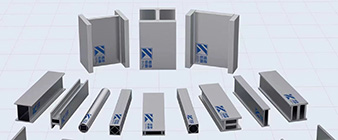The manufacture of 904L stainless steel structural components requires careful consideration to ensure required performance and quality. The following are key aspects of 904L stainless steel structural fabrication:
904L stainless steel can be easily welded using a variety of techniques, including TIG (tungsten inert gas), MIG (metal inert gas) and plasma arc welding.
Proper selection of welding parameters such as heat input, filler metal and shielding gas is critical to maintaining the required corrosion resistance and mechanical properties of the weld.
Welding procedures should be carefully developed and qualified to prevent the formation of harmful phases, such as sigma phases, which can compromise the corrosion resistance of the material.
In some cases, post-weld heat treatment may be required to restore the desired microstructure and properties.
904L stainless steel can be cut using a variety of methods, such as plasma cutting, laser cutting or abrasive waterjet cutting, depending on the complexity of the structural part.
The material’s high ductility and formability allow bending, rolling and other forming processes to create a variety of structural profiles, including I-beams, channels, angles and hollow structural profiles.
Forming parameters such as temperature, strain rate, and tool geometry must be carefully controlled to prevent surface defects or cracks during the manufacturing process.
Proper surface preparation is critical for 904L stainless steel structural components to ensure good corrosion resistance and aesthetic appearance.
Degreasing, pickling, and passivation treatments may be required to remove surface contaminants, scale, and oxide layers and to restore the passivation film on the stainless steel surface.
Surface finishing, such as polishing or brushing, can further enhance the appearance and cleanability of 904L stainless steel construction.
In addition to welding, 904L stainless steel structural components can be joined using mechanical fasteners such as bolts, rivets or screws, depending on application requirements.
To prevent galvanic corrosion between dissimilar metals, fastener materials and joint design must be carefully selected.
Proper alignment and assembly of structural components during assembly is critical to ensuring structural integrity and minimizing the risk of stress corrosion cracking.
Rigorous quality control measures, including visual inspection, non-destructive testing (e.g. ultrasonic testing, radiography) and mechanical testing, are critical to ensuring that manufactured 904L stainless steel structures meet required specifications and performance standards.
Proper recording and traceability of manufacturing processes, materials and test results are critical to ensuring the long-term reliability and safety of 904L stainless steel structures.
By following best practices in 904L stainless steel structural fabrication, manufacturers can produce high-quality, corrosion-resistant and durable structural components for a variety of industrial applications, particularly in the water treatment and chemical processing industries.
-
 2024-9-29 Alloy 59 / 2.4605 Nickel-Based Alloy Structural Profiles: Beams and Columns
2024-9-29 Alloy 59 / 2.4605 Nickel-Based Alloy Structural Profiles: Beams and Columns -
 2024-9-16 2205 duplex stainless steel in bridges of Innovative application
2024-9-16 2205 duplex stainless steel in bridges of Innovative application -
 2024-9-21 Application of S960 steel in bridge engineering
2024-9-21 Application of S960 steel in bridge engineering -
 2024-9-29 Alloy 602 CA / 2.4633/N06025 Nickel-based alloy hollow structural profiles
2024-9-29 Alloy 602 CA / 2.4633/N06025 Nickel-based alloy hollow structural profiles -
 2024-9-21 Effective design and construction of high-strength S690 steel
2024-9-21 Effective design and construction of high-strength S690 steel -
 2024-9-16 Alloy 718/2.4668/UNS N07718 Structural Stations applications
2024-9-16 Alloy 718/2.4668/UNS N07718 Structural Stations applications -
 2024-9-29 Alloy 2.4663 (N06617) Structural Hollow Profiles
2024-9-29 Alloy 2.4663 (N06617) Structural Hollow Profiles



